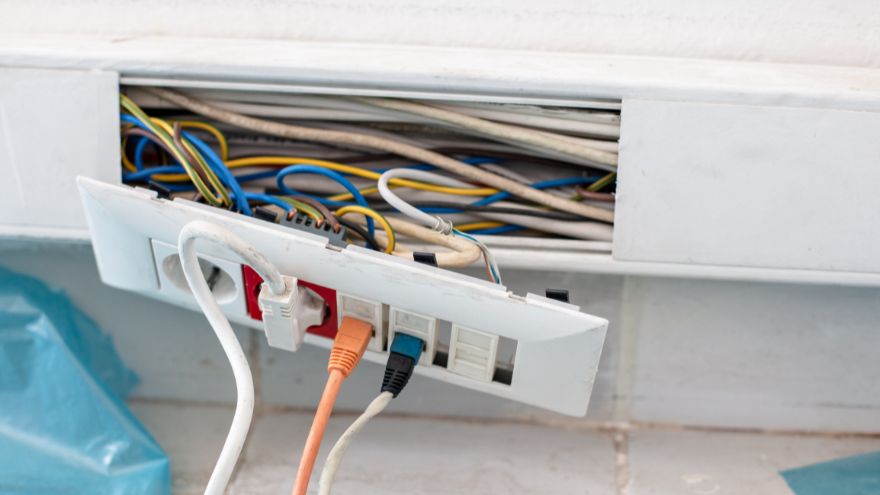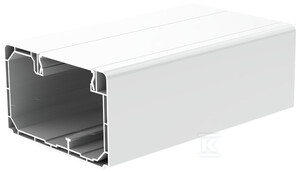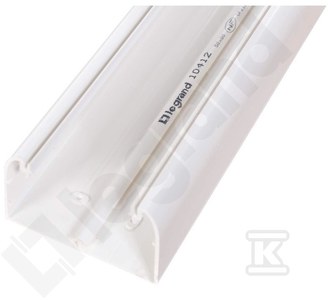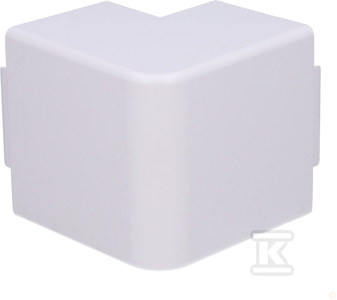Cable channels (also known as installation channels, cable strips or cable trays) are electrical installation elements intended for creating cable routes and various types of installations on the walls or ceilings of residential buildings and industrial facilities. Cables are placed in a cable duct and run above the ground, in the ground, in the floor or above its level. There are many types and sizes of cable channels, which allows each investor to select the optimal solution for their installation.

Check cable channels at the Onninen wholesaler
What applications can cable channels have?
Today, cable channels play a very important role in the construction of both large and small electrical or telecommunications installations inside buildings. Placing electrical cables in the channel makes them resistant to mechanical damage and allows installation elements to be discreetly incorporated into the decor. The cable channel is used to connect a fiber optic network to a house, apartment or company. It cannot be missing in industrial facilities, where in difficult conditions it protects numerous power cables against damage and dust, facilitates their organization and prevents serious accidents at work due to tripping over the tangle of cables on the floor. Depending on the application, an installation channel of the appropriate type and with the required parameters should be selected.
 In some places, especially in industrial spaces, cable ducts with a higher degree of protection against moisture, solid substances, impacts and cable heating are a necessity. Fire resistance of the cable duct is often required. Installation channels with a high fire resistance class are an integral element of fire protection of electrical installations. They are often installed in public buildings in corridors, which generally serve as escape routes. In the event of a fire, the fire-resistant casing protects cables and electrical wires from spreading fire, ensuring the continued operation of key systems and devices and preventing toxic gases and smoke from becoming visible in the air.
In some places, especially in industrial spaces, cable ducts with a higher degree of protection against moisture, solid substances, impacts and cable heating are a necessity. Fire resistance of the cable duct is often required. Installation channels with a high fire resistance class are an integral element of fire protection of electrical installations. They are often installed in public buildings in corridors, which generally serve as escape routes. In the event of a fire, the fire-resistant casing protects cables and electrical wires from spreading fire, ensuring the continued operation of key systems and devices and preventing toxic gases and smoke from becoming visible in the air.
What are the types of cable channels?
Cable channels are divided into three main groups: open, closed and ventilated. Moreover, the models available on the market differ in many parameters, including: material, size, shape, useful cross-section, number of units, operating temperature range, IP protection level, impact resistance, mounting method, presence of a cover and even color.
In addition to the standard "U" and "Sh" shapes, you can also find triangular and rounded cable channels on the market. A special type of cable channels are comb trays (organizers), intended for control and distribution cabinets. They ensure easy installation and protection of cables against dust and mechanical damage. Their characteristic, flexible "ribs" facilitate the pulling of cables. Special holes are used for mounting the tray in the cabinet.
Such a wide selection of cable channels allows you to lay cables in various places and purposes. This equipment is constantly improved - also in terms of aesthetics. Thanks to this, the cable trays fit better into the room.
What should you remember when installing a cable duct?
A typical cable tray consists of a body and a lockable cover. The special design ensures easy installation by screwing or gluing to a (previously cleaned) surface, e.g. on a wall or floor. Dedicated expansion pins are used to screw the channels. If you prefer the glued option, choose strips with double-sided adhesive tape. It is an effective, fast, simple and, what is important for many investors, non-invasive installation method. However, we do not recommend nailing the trays.
 Cable channels are typically sold in 2-meter lengths, so there is usually a need to connect them or, on the contrary, cut them into smaller pieces. The connection is generally made by cutting an appropriate hole in the second channel. There are also variants with a connectorless system to choose from. The trays are then connected by inserting one into the other and twisting them. Special connectors are recommended for heavy loads and when connecting strips from the same manufacturer so that all elements fit together perfectly. Only specialized, dedicated tools should be used to cut cable trays, e.g. miter cutters for cutting profiles. It's not just about user safety. Such a cutter will allow you to avoid damaging the element, curvatures, crushing or tearing the edges.
Cable channels are typically sold in 2-meter lengths, so there is usually a need to connect them or, on the contrary, cut them into smaller pieces. The connection is generally made by cutting an appropriate hole in the second channel. There are also variants with a connectorless system to choose from. The trays are then connected by inserting one into the other and twisting them. Special connectors are recommended for heavy loads and when connecting strips from the same manufacturer so that all elements fit together perfectly. Only specialized, dedicated tools should be used to cut cable trays, e.g. miter cutters for cutting profiles. It's not just about user safety. Such a cutter will allow you to avoid damaging the element, curvatures, crushing or tearing the edges.
It is worth knowing that wall mounting is not the only available option. Installation channels are successfully installed in furniture: reception desks, computer workstations, etc.
Check cable channels at the Onninen wholesaler
What should the cable channel be made of?
The cable channel should be made of high-quality material, resistant to mechanical damage, impacts and corrosion, ensuring very good electrical insulation and working in various conditions. The desired durability, safety of use and universality of use in electrical installations are provided by plastic trays made of PVC (polyvinyl chloride). Their advantage is also their low price.
Metal cable channels, made of e.g. galvanized steel or aluminum, are used to run cable routes in demanding installation projects.
What dimensions should the cable duct have?
 As we mentioned earlier, installation channels are usually sold in 2 m long sections. Widths, depths and heights vary greatly. They are usually 60 to 160 mm (width), 50 mm to 65 mm (depth) and 55 mm to 110 mm (height). Smaller cable trays are mainly suitable for home installations. Medium cable channels allow for laying cable routes, so they are used in offices and commercial facilities. Large cable trays, on the other hand, are commonly used in industrial spaces: factories, warehouses, workshops, production plants, etc.
As we mentioned earlier, installation channels are usually sold in 2 m long sections. Widths, depths and heights vary greatly. They are usually 60 to 160 mm (width), 50 mm to 65 mm (depth) and 55 mm to 110 mm (height). Smaller cable trays are mainly suitable for home installations. Medium cable channels allow for laying cable routes, so they are used in offices and commercial facilities. Large cable trays, on the other hand, are commonly used in industrial spaces: factories, warehouses, workshops, production plants, etc.
What accessories should you remember when selecting cable channels?
The most frequently chosen accessories for cable channels include: connectors, various types of angles (corners), end caps and separation partitions. Cutting tools are often purchased together with cable trays. The selection of accessories and tools depends on the installation requirements of the selected channels.
Cable channels in the Onninen wholesaler
At the Onninen electrical wholesaler , you will find electrical installation strips and cable channels in many different variants and sizes, ideal for home and commercial applications. The offered installation channels are characterized by a wide operating temperature range, increased IP protection level and high impact resistance. You can order from us both popular types and sizes of cable trays, as well as non-standard models for special applications.
Our product range includes popular PVC cable ducts (including models glued with double-sided adhesive tape), metal and plastic underfloor ducts, above-floor, halogen-free, flexible and shielding ducts, comb ducts for switchboards, as well as accessories and tools useful in the process of creating routes. cable. We cooperate only with renowned manufacturers and suppliers of electrical equipment, such as: Emiter , Kopos , Legrand .